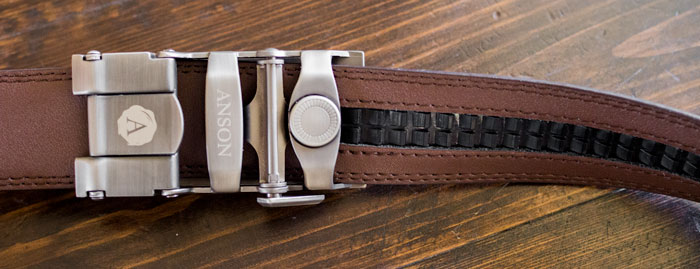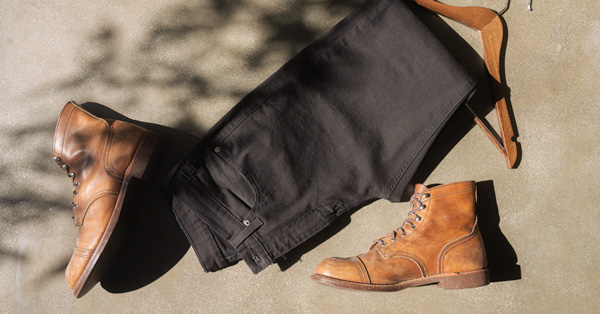 |
Swap buckles and belts and get a better fit, all backed up with a lifetime guarantee with Anson Belt & Buckle. We're proud to team up on this post. Click here to upgrade your belt.
What is this? |
Shedding pounds and hitting your goal weight is amazing for your body and your confidence, but it can present a challenge for your style. This is especially true if you’re in the process of quickly losing a significant amount of weight.
After all, you’ve probably spent a few years assembling a wardrobe that works for the body you used to have. You’re thrilled to be looking and feeling better underneath that XL button-down, but you want your style to reflect all your hard work.
Sure, the clothes can make the man. But you want the man and the clothes to be on roughly the same page.
Updating your style after (or during) weight loss can run into serious cash, and lead to some tricky questions: do you update all at once, or in stages? How permanent are the changes? Are you at your new, stable weight? Will you continue to shed kilos, or gain some of it back?
While the answers to these questions vary widely person to person, we’ve put together a few simple, budget-friendly hacks for the period while you’re losing weight to look good and save cash.
1. Microadjustable, Holeless Belt
Surprisingly, regular belts can only see you through a weight transition if they were pretty new when you started losing weight. Why?
As you’ve probably noticed, leather belts quickly develop creases and indentations from the buckle, especially when under a higher load. So by the time you're at your lower weight your belt will have all kinds of unsightly marks and notches.
Anson belts don’t have this problem because they don’t rely on a buckle to create a secure, easily-adjustable hold.
Anson belts use a ratchet style track system that eliminates holes – and the creasing and stress on the leather belt face.

The ratchet system on the back of an Anson belt
Instead of five holes an inch apart (who came up with that, anyway?) the Anson buckling mechanism allows for 30 options spaced a quarter of an inch apart – a must if you’re losing between five and ten pounds a month.
The Anson system allows for micro adjustments perfect for when weight fluctuates, or even when different items are made from thinner or thicker fabrics. It’s even more versatile when you consider that all Anson belts and buckles within the same width are 100% interchangeable.
In addition to being a smart buy, Anson belts come in a variety of colors and materials. Of note is that all of their leather belts are crafted from full grain leather for a premium look and feel, and long-lasting durability.

An Anson belt paired with a stretch shirt from Mizzen & Main and stretch denim from Gap, which leads us to…
2. Stretch-Fit Jeans
Here at Primer we’ve closely examined selvedge denim as a style choice, and even shown you a DIY hack for achieving a perfectly-fitting pair of raw denim jeans.
The thing is, if you’re going through a period of intensive weight loss you probably don’t want to drop several hundred bucks on the perfect pair of raw or selvedge denim if they’re going to be too big in three months. On the other hand, they’ll be so far from broken in you can probably return ‘em and claim they were never worn!
We love the selvedge look. But sometimes jeans with the right amount of give have a role to play.
What does stretch-fit mean? In practice, stretch-fit jeans incorporate anywhere from 1-20% stretchable fibers into the jeans blend, with 1% providing a little give and 20% allowing you to kick people in the face with ease.
The major style bonus to stretch fit jeans when you’re losing weight is you can buy a size down and let your body catch up to the fit. They also re-tighten their fit after washing far more than non-stretch, 100% cotton sanforized jeans.
At the top end of stretch and the low end of price check out American Eagle’s Extreme Flex. Levi’s offers their own high-stretch model, the 511 Performance Stretch Jean.
For less flex and a more traditional jean, check out the 1% Levi’s 511 Slim Fit Jean.
3. When to Pay the Tailor Tax
Old joke: gym gains that make you bigger (or smaller), a diet that shrinks your waistline, a lifestyle change helps you achieve your target weight… time to pay the tailor tax.
The straight good news when it comes to tailoring clothes after weight loss is that the fabric is in your favor: you already have bigger pieces that can be brought in. From there, it gets more complicated.
There are two schools of thought on what clothes you should tailor and which you should buy again. On one hand it makes sense to tailor the items you wear all the time so you can keep wearing them.
On the other, you could argue it's better to buy new versions of the items you love to wear so they'll last longer and you can tailor the pieces you don't wear quite as often, allowing you to keep wearing them without paying full price for something you don't wear a lot.
Regardless of which strategy you decide on, it’s important to keep costs in mind. If you already have some nicer items, such as blazers, it can be cheaper to tailor them as you go rather than buying all new items.
If you’re in doubt about your suits or blazers, check out Primer’s guide to how your suit should fit.
But if you’re dropping serious weight you can't tailor forever, and tailoring bills add up. Consider this example:
You have a favorite pair of pants. Pant waists can be adjusted about 2 sizes, but not much more. Along with the waist, the crotch will likely also need brought in. Should you do it?
Adjusting the waist and crotch on $50 pants probably isn't worth it. You'll be paying about half that in tailor costs. If they originally ran you $100+ the tradeoff starts to look more appealing, but keep in mind – alterations to the waist will also bring the back pockets closer together.
4. Collar Hack
Button-up shirts offer a lot of flexibility when it comes to weight gain. As long as the fit isn’t too baggy, you can hide some of the extra fabric by rolling up billowy sleeves and using the military tuck to hide the excess, with a well-fitting blazer on top.

The Military Tuck – Check out our full guide to How a Shirt Should Fit
One area that’s truly difficult to hide, however, is the collar. If your neck has shrunk, you don’t want a too-big collar to make you look like a kid in his dad’s suit.
In the intermediate stage before replacement or major tailoring is called for, you can hack this issue by simply moving the top button to the right (i.e., away from the centerline of the body) by up to a half inch.
Simple to do yourself or very cheap to hand off to a tailor, this trick can help extend the life of a shirt you’ve under-grown.
5. Superfeet Insoles
Lesser-known fact: when you lose weight, you lose weight all over your body (well, nearly all over). This includes face, arms, neck, even your wrists. And definitely your feet.
One friend of the magazine who lost nearly 100 pounds went from needing a 12 to a 10 in most shoes. While we’re super proud of him, that’s a serious hit to your wallet if you need to replace every single workhorse shoe, boot, and sneaker in your lineup.
Chances are your target weight isn’t so dramatic. Most guys report more slip in their usual footwear after weight loss. At most you might go down a half size.
In these situations, there’s an alternative to replacing your shoe rack: pick up a quality insole.
For a few years now Superfeet have been at the top of the game, making quality insoles in a variety of styles and rigidities.
Generally, insoles are meant to replace the flimsy piece of foam that came with your footwear but if you really need to fill space simply place the additional material on top of the existing insole.
Have you had to change up your style because of weight loss or gym gains? Share your story below!
Special thanks to Anson Belt & Buckle for partnering with us on this post! Thank you for supporting the brands that support Primer!
https://www.youtube.com/watch?v=xLel1A1WJVk





















